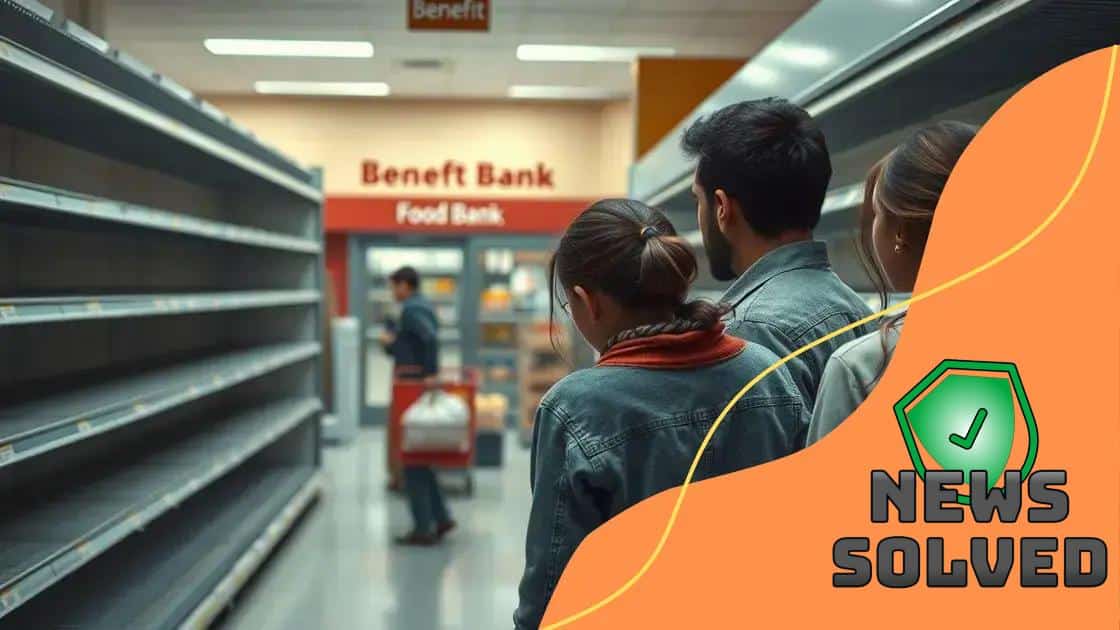Understand the SNAP benefits reduction and the impact on vulnerable families

Advertisements
The SNAP benefits reduction is shaking the foundation of food security for vulnerable families, making it harder for them to access essential nutrition. As assistance shrinks, the reliance on community resources intensifies, putting health at risk.
What happens when the support families depend on starts to vanish? The impact goes beyond just a financial strain, it stretches into every meal, every grocery trip, and the stability of households.
This issue is not just a policy debate; it’s a reality for millions. As we explore the effects of these cuts, we uncover a story of resilience, but also of growing uncertainty.
Advertisements
Understanding SNAP benefits
The Supplemental Nutrition Assistance Program (SNAP), formerly known as food stamps, is a vital federal initiative designed to assist low-income individuals and families in purchasing nutritious food.
Administered by the U.S. Department of Agriculture (USDA), SNAP aims to alleviate food insecurity and promote better health outcomes among its recipients.
In 2024, approximately 42 million Americans benefited from this program, highlighting its significance in the nation’s social safety net.
Advertisements
SNAP benefits are typically distributed through an Electronic Benefits Transfer (EBT) card, functioning similarly to a debit card.
This system allows recipients to purchase eligible food items from participating retailers, ensuring they have access to a variety of nutritious options.
Eligible items include fruits, vegetables, dairy products, meats, and grains, among others. However, the program excludes non-food items such as alcohol, tobacco, and household supplies.
The recent proposed reductions to SNAP benefits, as part of the “One Big Beautiful Bill,” have raised concerns about the program’s future.
These cuts could significantly impact vulnerable populations, including children, the elderly, and individuals with disabilities, by limiting their access to essential nutrition.
Key features of SNAP benefits
- Eligibility is determined by income, household size, and expenses.
- Benefits vary based on household needs and same-state guidelines.
- SNAP aims to reduce hunger and improve nutrition among low-income groups.
- There is a process for appeal if benefits are denied or reduced.
Besides providing funds for food, SNAP also has educational programs that teach recipients about nutrition and cooking. These resources can help families make healthier food choices, which is vital for overall well-being.
Another significant factor is that the program can change with political and economic climates, leading to fluctuations in funding and benefits.
Understanding these aspects is important, especially since many families might face uncertainties about their SNAP benefits.
Awareness about the eligibility criteria and application process can empower families to make informed decisions. With the impending reductions in benefits, it’s even more pressing for recipients to stay informed.
Understanding how SNAP benefits operate and the potential consequences of proposed changes is crucial for informed discussions about the program’s role in supporting vulnerable families.
Who is affected by SNAP benefits reduction?
The proposed SNAP benefits reduction, part of the “One Big Beautiful Bill Act,” threatens to significantly impact vulnerable populations across the United States.
The Congressional Budget Office estimates that these cuts could result in 3.2 million adults losing monthly benefits, including 1 million older adults aged 55–64.
Among the most affected are families with children, the elderly, and individuals with disabilities.
For instance, a report from First Focus on Children and UnidosUS warns that 14 million children could lose both food stamps and healthcare benefits under the proposed federal budget.
This dual loss could lead to increased food insecurity and adverse health outcomes for these children.
Groups particularly impacted
- Low-income families struggling to provide balanced meals.
- Single-parent households that rely heavily on assistance.
- The elderly, who may already face limited income sources.
- Individuals with disabilities, who may need additional support.
Consider a single mom balancing work and caregiving for her children. With SNAP cuts, she must adjust her shopping habits, often prioritizing cheaper, less nutritious foods. This scenario highlights the ripple effect of these reductions.
The impact extends beyond individuals to communities and local economies. In Texas, for example, food banks are voicing concerns that the proposed SNAP cuts could strain their resources, as more families turn to them for assistance.
Celia Cole, CEO of Feeding Texas, highlighted that the shift of SNAP costs to states could cost Texas over $1.1 billion annually, potentially leading to reduced support for low-income residents.
Potential consequences of reduced benefits

When discussing the potential consequences of reduced benefits, it’s important to recognize the wide-ranging effects these changes can have on individuals and families.
Cuts to SNAP benefits can lead to immediate challenges for those who depend on this essential support.
One major consequence is the increased risk of food insecurity. Families may find it harder to stretch their budgets to cover essential groceries.
With less assistance, many may skip meals or turn to cheaper, less nutritious options, leading to negative health outcomes.
Health Implications
Research indicates that SNAP participation is linked to improved health outcomes and lower healthcare costs.
For instance, a study found that toddlers and preschoolers in households with access to food stamps had better health outcomes at ages 6–16 compared to similar children who did not have access to food stamps.
Additionally, higher participation in SNAP is associated with lower overall and male suicide rates. Reducing SNAP benefits could reverse these positive health trends, leading to increased health disparities among vulnerable populations.
Economic Impact
SNAP not only supports individual households but also stimulates local economies. For every $1 in SNAP benefits, approximately $1.50 in local economic activity is generated.
In Texas, for example, SNAP contributed approximately $10.73 billion in economic activity in 2024 and supported over 94,000 jobs.
Reductions in SNAP benefits could lead to decreased consumer spending, negatively affecting local businesses and potentially leading to job losses.
Strain on Community Resources
As SNAP benefits decrease, more individuals and families may turn to food banks and community programs for assistance. However, these organizations are already facing challenges in meeting the growing demand for services.
For example, the Blue Ridge Area Food Bank reported a historic surge in demand, with guest visits exceeding 170,000 each month, the highest number in their 43-year history.
Further cuts to SNAP could overwhelm these organizations, making it challenging for them to provide adequate support to those in need.
Educational and Developmental Consequences
SNAP plays a crucial role in supporting children’s health and development. Studies have shown that children in families receiving SNAP are less likely to experience food insecurity and developmental risks.
Reductions in SNAP benefits could lead to increased food insecurity among children, potentially affecting their academic performance and overall well-being
Alternatives for families facing SNAP benefits reduction
Families facing reductions in SNAP benefits often need to explore alternative options to ensure they can access food and essential resources.
Understanding these alternatives is key to navigating challenging times. Many families may feel overwhelmed, but various resources can help.
One option is reaching out to local food banks. These community resources provide food assistance to those in need.
Many food banks offer fresh produce, canned goods, and other staples. They often have no-cost services, making them a valuable ally for families struggling to make ends meet.
Additional alternatives to consider
- WIC (Women, Infants, and Children) program offers food assistance for eligible families with young children.
- Community meal programs provide free or low-cost meals at local churches or community centers.
- School meal programs ensure children receive nutritious meals during school hours, even during breaks.
- Food co-ops or farmer’s markets sometimes offer discounts for low-income families, promoting access to fresh food.
Many families may also consider budgeting and meal planning as essential tools. Planning meals can help stretch limited resources and minimize food waste.
Creating a shopping list can guide families in making healthier choices while staying within their budget. Cooking in batches or utilizing leftovers effectively are also excellent strategies.
Exploring local government programs is another way families can find support. Some states offer assistance beyond SNAP, such as cash benefits or housing support.
By reaching out to local social service agencies, families can tap into various resources available to help them manage during difficult times.
Lastly, connecting with support groups or online communities can offer emotional support and practical advice. Sharing experiences with others facing similar challenges can help families feel less isolated.
Additionally, these groups often exchange tips on navigating food insecurity effectively.
Resources to consider for support
- Local churches or religious organizations that often run food pantries.
- Community service organizations that can provide groceries and personal care items.
- Online platforms that help users find meal programs in their area.
- SNAP outreach programs that offer guidance on assistance applications and benefits.
In addition to food resources, families should consider budgeting and meal planning as supportive tools.
Sticking to a budget allows families to prioritize spending and make the most of limited resources. Meal planning helps reduce waste and encourages healthier eating habits, easing the strain on grocery budgets.
Joining community groups or online forums that focus on food assistance can offer valuable support. Connecting with others in similar situations provides emotional encouragement and practical advice.
These groups can also inform members of upcoming food distribution events or new local services available for people in need.
Finally, staying informed about policy changes is crucial. Being aware of modifications to SNAP and related programs can empower families to adapt quickly.
When they know their rights and resources, individuals can better advocate for themselves and their communities.
The role of policy in SNAP benefits

The role of policy in SNAP benefits is crucial to understanding how this vital program operates. Changes in legislation can directly impact the amount of assistance available to families in need.
SNAP, or the Supplemental Nutrition Assistance Program, relies on federal and state policies to determine eligibility, benefit amounts, and program structure.
Every few years, policies can shift based on political priorities and economic conditions.
For example, during economic downturns, there may be an increase in funding or program expansions to accommodate the growing number of individuals requiring food assistance.
Conversely, budget cuts can lead to reduced benefits and stricter eligibility requirements, making it harder for families to qualify.
Key areas of policy impact
- Eligibility criteria determine who can apply for SNAP, often based on income and household size.
- Benefit levels set limits on how much assistance families receive monthly.
- Program administration involves how states implement SNAP, including outreach and support services.
- Policy changes can promote enhancements, such as allowing for more online purchasing options or increased funding for nutrition education.
State policies can also create variations in how SNAP functions across the country. Some states have more flexible policies that can help families access benefits more easily, while others may have stricter guidelines.
Understanding these differences is important for recipients to know their rights and access available resources.
Moreover, advocacy plays a significant role in shaping SNAP policies. Community organizations and individuals often work together to lobby for changes that can improve the program.
These efforts may focus on addressing food insecurity issues, expanding eligibility, or enhancing benefits to meet the rising cost of living.
Staying informed about upcoming policy changes is essential for families relying on SNAP. Awareness can empower individuals to voice their concerns and needs, leading to more effective support systems overall.
Engaging with local advocacy groups can also create a platform for sharing experiences and pushing for necessary changes in food assistance policies.
Also read our content on Social Security’s $2,000 Milestone.
FAQ – Frequently Asked Questions about SNAP benefits reduction
What are SNAP benefits?
SNAP benefits, or Supplemental Nutrition Assistance Program benefits, help low-income individuals and families purchase food, ensuring they have access to nutritious meals.
Who can qualify for SNAP benefits?
Eligibility for SNAP benefits is determined by income, household size, and certain expenses. Generally, low-income families and individuals can qualify.
What should I do if my SNAP benefits are reduced?
If your SNAP benefits are reduced, consider exploring local food banks, community programs for food assistance, and resources for budgeting and meal planning.
How can policy changes affect SNAP benefits?
Policy changes can either increase or decrease the funding and resources available for SNAP, impacting eligibility criteria, benefit amounts, and program access.





